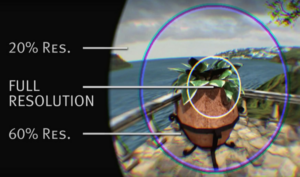SensoMotoric Instruments (SMI) says it has showed a system to lower the requirements of virtual reality processing. Using the ‘foveated rendering’ technique, VR performance can be between two and four times higher than is possible today, said SMI OEM director Christian Villwock.
Using foveated rendering, resolution of an image can be made highest where the user is looking (where their fovea is), and taper off towards the edges. It takes advantage of a peculiarity of human vision; when looking at an object only the centre of your vision is actually perfectly clear; visual resolution becomes less clear as it approaches the peripheral.
By applying the system to an image, experiences could be rendered realistically using today’s CPU and GPU hardware. This is because the computer has much less information to render, and only needs to output full resolution where the user is looking. VR could be rendered in anything up to 11k, said SMI. Oculus’ chief scientist, Michael Abrash, has previously said that realistic VR requires 8k for each eye.
Previous attempts at foveated rendering broke immersion, as they were not fast enough to keep up with eye movements. The area of high resolution would trail behind the eyes’ path. SMI has achieved worked with image sensor company OmniVision, creating a system that can track eye movements at 250Hz.
Villwock told Upload VR, “There is this magic number of 240Hz that we have found through over ten years of research…at this rate you can start measuring saccadic eye movements”. Saccadic eye movements are the rapid, simultaneous movements eyes make when they fixate on a single point.
So far, SMI has only shown its eye tracking kits with the Oculus Rift, but Villwock has said that the company is working on “a successor project” with several companies “on the PC side and also on the mobile side”.

